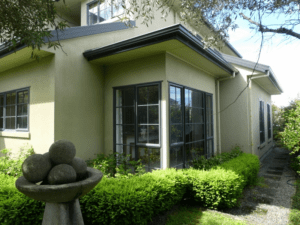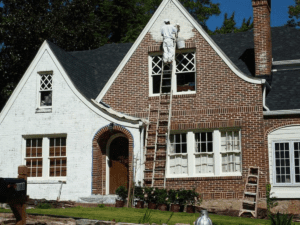
As a homeowner, one of the most important decisions you will make is choosing the right type of paint for your exterior house. The paint you select not only enhances the aesthetic appeal of your home, but also acts as a protective barrier against the elements. In this article, I will guide you through the process of understanding the importance of exterior house paint selection and provide insights into the various types of paints available in the market.
Understanding the Importance of Exterior House Paint Selection
Selecting the right paint for your exterior house is crucial, as it directly impacts the durability and longevity of your home’s exterior. The exterior of your house is constantly exposed to harsh climatic conditions, such as sunlight, rain, and extreme temperatures. Therefore, the paint you choose should be able to withstand these elements and provide adequate protection to your home.
Climatic Conditions and Their Impact on Exterior Paint Performance
Before delving into the different types of exterior house paints, it is important to understand how climatic conditions can affect paint performance. In regions with high humidity, moisture resistance becomes a key consideration. Paints that are specifically formulated to resist moisture can prevent damage caused by water infiltration, such as peeling, cracking, or blistering.
Similarly, in areas with intense sunlight, UV resistance is crucial to prevent the paint from fading or chalking over time. Paints with UV inhibitors can help maintain the vibrant color and appearance of your exterior for longer periods. Additionally, extreme temperature fluctuations can cause expansion and contraction of the materials, leading to paint failure. Opting for paints that are designed to withstand these temperature changes is essential for a long-lasting finish.
Exposure to Sunlight, Rain, and Other Environmental Factors
The exterior of your house is exposed to a wide range of environmental factors, including sunlight, rain, wind, dust, and pollutants. These factors can cause significant damage to the paint over time if it is not properly chosen. Therefore, it is important to consider the specific conditions your house will be exposed to when selecting the paint type.
Water-based paints, also known as acrylic latex paints, are a popular choice for exterior surfaces due to their durability and versatility. These paints are easy to apply, dry quickly, and provide excellent color retention. They also offer good resistance to cracking, peeling, and fading. Water-based paints are suitable for a variety of exterior surfaces, including wood, metal, and masonry.
On the other hand, oil-based paints, also known as alkyd paints, have been traditionally used for exterior surfaces. They offer superior adhesion and durability, making them suitable for areas that experience heavy wear and tear. However, oil-based paints take longer to dry and may emit strong odors during application. They also tend to yellow over time, especially on lighter colors. Therefore, it is important to weigh the advantages and disadvantages before opting for oil-based paints.
Types of Exterior House Paints: Oil-Based vs. Water-Based
When it comes to selecting the type of paint for your exterior house, you have two main options: oil-based or water-based paints. Each type has its own advantages and disadvantages, so it is important to consider your specific requirements before making a decision.
Acrylic Latex Paints: Durability and Versatility for Exteriors
Acrylic latex paints, also known as water-based paints, have gained popularity in recent years due to their durability and versatility. These paints are easy to apply, clean up with water, and have a low odor. They provide excellent color retention and resist cracking, peeling, and fading. Acrylic latex paints are suitable for various exterior surfaces, including wood, metal, and masonry. They are also available in a wide range of finishes, from flat to high gloss, to suit your desired aesthetic.
Alkyd/Oil-Based Paints: Advantages and Disadvantages for Exterior Use
Alkyd or oil-based paints have been the traditional choice for exterior surfaces due to their superior adhesion and durability. These paints provide a hard, protective coating that is resistant to wear and tear. They are ideal for areas that experience heavy traffic or require frequent cleaning. However, oil-based paints have a longer drying time and emit strong odors during application. They also tend to yellow over time, especially on lighter colors. It is important to weigh these advantages and disadvantages before deciding to use oil-based paints for your exterior house.
Specialized Paints for Specific Exterior Surfaces (Wood, Stucco, etc.)
Different exterior surfaces require specific types of paint to ensure optimal performance and longevity. For example, wood surfaces benefit from paints that offer flexibility and breathability to prevent cracking or peeling. Stucco surfaces, on the other hand, require paints that can withstand the expansion and contraction caused by temperature changes. It is important to consult with a paint professional or refer to manufacturer guidelines to determine the best paint type for your specific exterior surface.
Considerations for Paint Finishes: Flat, Satin, Semi-Gloss, or Gloss
The finish of your exterior house paint not only affects the overall appearance but also plays a role in the paint’s performance. Different finishes have different levels of sheen and durability, making them suitable for specific areas of your home’s exterior.
Flat finishes have a low sheen and are ideal for concealing surface imperfections. They provide a smooth, matte appearance but are less resistant to stains and require more maintenance. Satin finishes offer a subtle sheen and are more durable than flat finishes. They are easy to clean and are suitable for areas that require frequent washing, such as doors or windows. Semi-gloss and gloss finishes have a high sheen and offer superior durability and stain resistance. They are commonly used on trim, doors, and shutters to provide a striking contrast to the main body of the house.
Paint Formulations for Improved Moisture Resistance and Longevity
Moisture resistance is a critical factor to consider when selecting exterior house paint, especially in areas with high humidity or frequent rainfall. Paints that are specifically formulated to resist moisture can prevent damage caused by water infiltration, such as peeling, cracking, or blistering. These formulations often include additives that create a protective barrier, preventing water from seeping into the underlying materials. It is important to look for paint products that explicitly mention their moisture resistance properties to ensure long-lasting performance.
Eco-Friendly and Low-VOC Exterior House Paint Options
In recent years, there has been a growing demand for eco-friendly and low-VOC (volatile organic compound) paint options. These paints are formulated with fewer harmful chemicals, making them safer for both human health and the environment. Low-VOC paints have reduced levels of toxic emissions and odors, making them suitable for those with sensitivities or allergies. They are available in a wide range of colors and finishes, and many reputable paint manufacturers now offer eco-friendly options in their product lines. Choosing an eco-friendly paint not only benefits your health but also contributes to a more sustainable future.
Preparing Exterior Surfaces for Optimal Paint Adhesion
Before applying any exterior house paint, it is essential to properly prepare the surfaces to ensure optimal adhesion and long-lasting results. The preparation process may involve cleaning, scraping, sanding, and priming, depending on the condition of the existing surface. It is important to remove any dirt, debris, or loose paint before applying a fresh coat of paint. Proper surface preparation helps the paint adhere better, resulting in a smoother and more durable finish. Following manufacturer guidelines and industry best practices for surface preparation is crucial to achieve optimal results.
Professional-Grade vs. Consumer-Grade Exterior House Paints
When it comes to choosing exterior house paint, you will come across both professional-grade and consumer-grade options. Professional-grade paints are often used by contractors and painters due to their high-quality formulations and superior performance. These paints are designed to withstand harsh conditions, provide excellent coverage, and offer long-lasting results. Consumer-grade paints, on the other hand, are more readily available and often come at a lower price point. While they may still offer satisfactory results, they may not be as durable or have the same level of performance as professional-grade paints. It is important to consider your budget, the specific requirements of your project, and consult with professionals to determine the most suitable paint option for your exterior house.
Cost Comparisons and Budget Considerations for Exterior Paint Types
The cost of exterior house paint can vary significantly depending on the type, brand, and quality of the product. Oil-based paints are generally more expensive than water-based paints due to their superior durability and adhesion properties. Professional-grade paints also tend to be more expensive compared to consumer-grade paints, as they often use higher-quality ingredients and undergo more rigorous testing. It is important to consider your budget and strike a balance between cost and quality when selecting the paint type for your exterior house. Investing in a high-quality paint may initially cost more but can save you money in the long run by reducing the need for frequent repainting or repairs.
Manufacturer Recommendations and Industry Best Practices
When choosing exterior house paint, it is always beneficial to refer to manufacturer recommendations and industry best practices. Reputable paint manufacturers often provide detailed guidelines on surface preparation, application techniques, and maintenance to ensure optimal results. Following these recommendations can help you avoid common pitfalls and achieve a professional-quality finish. Additionally, consulting with professionals, such as painters or contractors, can provide valuable insights and recommendations based on their experience and expertise. Taking into account both manufacturer recommendations and industry best practices will help you make an informed decision and ensure the best outcome for your exterior house paint project.
In conclusion, selecting the right type of paint for your exterior house is crucial for both aesthetics and protection. Understanding the impact of climatic conditions, choosing between oil-based and water-based paints, considering specialized paints for specific surfaces, and paying attention to finishes and paint formulations are all key factors in making an informed decision. Additionally, preparing the exterior surfaces properly, considering eco-friendly options, and weighing cost and budget considerations are important steps in the process. By following manufacturer recommendations and industry best practices, you can ensure a successful and long-lasting exterior house paint project. So, take your time, do your research, and choose the paint that will not only beautify but also protect your home for years to come.
CTA: For professional advice and high-quality exterior house paints, contact our team of experts today!



